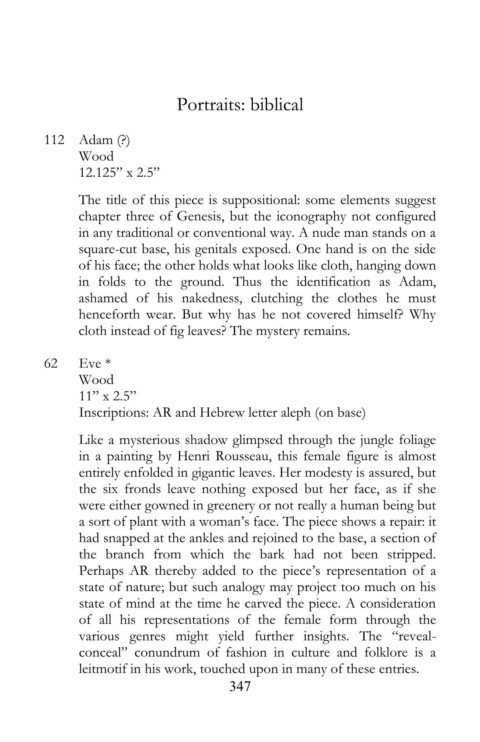Page 351 - The Legacy of Abraham Rothstein - text
P. 351
Portraits: biblical
112 Adam (?)
Wood
12.125” x 2.5”
The title of this piece is suppositional: some elements suggest
chapter three of Genesis, but the iconography not configured
in any traditional or conventional way. A nude man stands on a
square-cut base, his genitals exposed. One hand is on the side
of his face; the other holds what looks like cloth, hanging down
in folds to the ground. Thus the identification as Adam,
ashamed of his nakedness, clutching the clothes he must
henceforth wear. But why has he not covered himself? Why
cloth instead of fig leaves? The mystery remains.
62 Eve *
Wood
11” x 2.5”
Inscriptions: AR and Hebrew letter aleph (on base)
Like a mysterious shadow glimpsed through the jungle foliage
in a painting by Henri Rousseau, this female figure is almost
entirely enfolded in gigantic leaves. Her modesty is assured, but
the six fronds leave nothing exposed but her face, as if she
were either gowned in greenery or not really a human being but
a sort of plant with a woman’s face. The piece shows a repair: it
had snapped at the ankles and rejoined to the base, a section of
the branch from which the bark had not been stripped.
Perhaps AR thereby added to the piece’s representation of a
state of nature; but such analogy may project too much on his
state of mind at the time he carved the piece. A consideration
of all his representations of the female form through the
various genres might yield further insights. The “reveal-
conceal” conundrum of fashion in culture and folklore is a
leitmotif in his work, touched upon in many of these entries.
347

